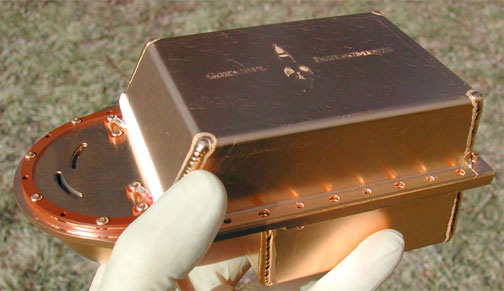PASS
In 2009, both prime contractors that were competing to build the TSAT satellite included what was then called the "SCM-2" in their proposed design. The SCM-2 was the SCM modified to determine high level charging, as expected in geosynchronous orbit (GEO). The SCM-2 was to be an integral part of the Space Micro, Inc. space weather suite (SEMS). Two views of the proposed SEMS instrument are shown below. The gold-colored hemispherical analyzer of the SCM-2 is visible in both views. The SCM-2 electronics where to be housed in the grey-colored box adjacent to the hemisphere.

A proposed stand-alone version of the SCM-2, the Plasma Analyzer for Space Science (PASS), would use two methods to determine spacecraft floating potential from +500 volts to -10,000 volts:
- PASS would use the same technique the SCM uses for monitoring low level charge (the 'electron-spectroscopic' method, as detailed in "Instrument for Measuring Spacecraft Potential").
- Additionally, PASS would use the “low energy ion cutoff” method to measure high-level negative floating potentials. Use of two methods simultaneously would assure great reliability in the measurement of spacecraft charge over the entire +500 volt to -10,000 volt range.
Below is an artist's concept of what the PASS instrument could look like, based on the SCM. Note the two arcuate entrance aperture/collimators for the hemispherical analyzer.

The January 2012 Special Spacecraft Charging Issue of IEEE Transactions on Plasma Science will include an in-depth description of the proposed PASS instrument. A prepublication copy of the paper is available here.
